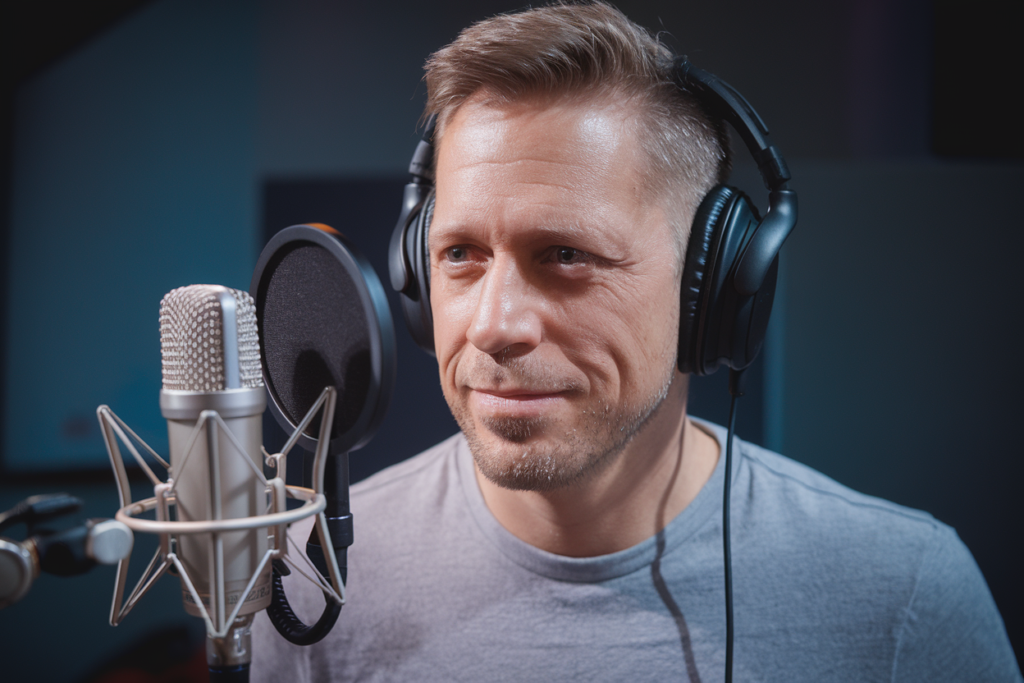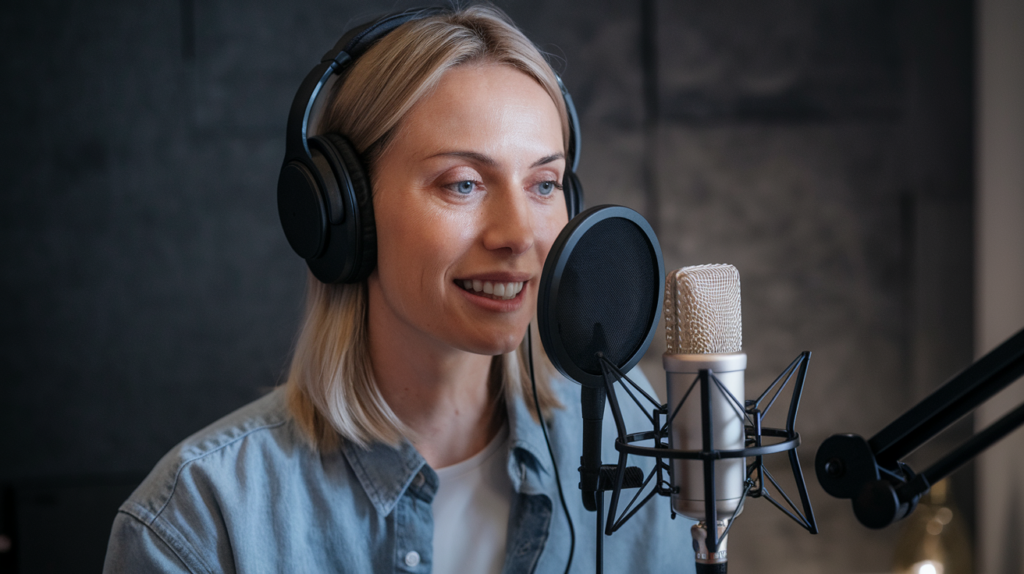Key Takeaways
- Importance of Lip-Sync: Lip-sync is vital in German dubbing, ensuring dialogue aligns with character movements for a natural viewing experience and emotional resonance.
- Role of Voice Actors: Skilled voice actors are crucial for effective lip-sync; they must replicate not just the words but also the emotions and nuances of the original performances.
- Techniques Involved: Key techniques include audio matching and visual synchronization, which help maintain authenticity by aligning vocal delivery with both timing and visual cues.
- Challenges Faced: Timing, language structure differences, and emotional expression present significant challenges that require meticulous analysis from voice actors to achieve accurate lip-sync.
- Future Innovations: Advancements in technology, including AI, promise to enhance synchronization methods while fostering collaboration among production teams for more authentic portrayals.
- Cultural Sensitivity: Understanding cultural contexts is becoming increasingly important in adapting performances to ensure relatability for local audiences amidst a diverse range of global content.
Ever wondered how your favorite shows manage to sound so natural in German? Lip-sync for German dubbing TV films plays a crucial role in making that happen. It’s not just about translating words; it’s about capturing the essence and emotion of the original performance.
Overview of Lip-Sync in German Dubbing
Lip-sync plays a crucial role in the success of German dubbing for TV films. It ensures that the dialogue matches the movements of characters’ lips, creating a seamless viewing experience. This technique goes beyond simple translation; it involves capturing the essence and emotion of performances.
Voice actors must synchronize their delivery with the original audio closely. They analyze each scene, noting pauses and intonations to maintain authenticity while speaking in German. This attention to detail helps preserve character nuances and emotional depth.
The choice of voice talent significantly impacts lip-sync quality. Skilled voice artists possess an understanding of timing and rhythm, allowing them to replicate the original performance accurately. A talented voice over actor adapts their vocal style to fit different characters, enhancing believability.
Moreover, effective lip-sync requires collaboration among various professionals in production. Directors guide voice actors during sessions, ensuring the final product resonates with audiences. Sound engineers also play a vital role by adjusting audio levels for clarity and impact.
Ultimately, successful lip-sync in German dubbing enhances viewer engagement and satisfaction. When done right, it transforms foreign content into relatable experiences that connect with local audiences.
Importance of Lip-Sync in Dubbing
Lip-sync is essential in German dubbing for TV films, as it ensures dialogue aligns perfectly with character movements. This synchronization creates a natural and immersive experience for viewers. When done correctly, lip-sync enhances emotional resonance, making foreign content relatable to local audiences.
Enhancing Viewer Experience
Effective lip-sync directly impacts viewer engagement. When the voices match the characters’ lips, you’re drawn into the story without distraction. It allows you to focus on the narrative rather than questioning translation accuracy or timing issues. Voice talent plays a crucial role here; skilled voice actors adjust their delivery to mirror not just words but also emotions conveyed through facial expressions and gestures. This attention to detail transforms how you perceive performances, ensuring they resonate deeply.
Maintaining Actor Performance
Lip-sync preserves the authenticity of original actor performances during dubbing. You might have noticed that successful adaptations capture not only what’s said but how it’s expressed. A talented voice artist analyzes each scene’s nuances before recording, ensuring their vocal interpretation matches the intent behind the original performance. This meticulous approach helps maintain character integrity while speaking in German, fostering an authentic connection between actors and audiences. Effective collaboration among directors and sound engineers further enhances this process, contributing significantly to overall production quality and viewer satisfaction.
Techniques Used in Lip-Sync for German Dubbing
Lip-sync techniques in German dubbing involve precise methods to ensure dialogue aligns seamlessly with character movements. These techniques enhance the viewer’s experience while retaining the essence of the original performance.
Audio Matching
Audio matching focuses on synchronizing the voiceover with the character’s mouth movements. Voice actors analyze each scene, ensuring their delivery matches not only words but also timing and emotion. They adjust pitch, tone, and pace to create a natural sound that resonates with audiences. For instance, when a character expresses excitement or sadness, skilled voice artists modify their vocal delivery accordingly. This careful attention helps maintain emotional integrity and ensures that viewers connect with characters on a deeper level.
Visual Synchronization
Visual synchronization involves aligning dialogue with specific visual cues in scenes. Voice over talent must observe facial expressions and gestures closely to replicate these nuances effectively. To achieve this, voice over actors often engage in extensive rehearsals, allowing them to integrate emotional cues into their performance seamlessly. This technique enhances authenticity by mirroring how original actors express feelings through body language and expressions. When done well, visual synchronization captivates viewers and makes foreign content feel relatable within a local context.
By employing these techniques diligently, production teams can deliver high-quality dubbing that enriches storytelling for German-speaking audiences while preserving the artistry of the original performances.
Challenges in Lip-Sync for German Dubbing
Achieving effective lip-sync in German dubbing poses several challenges that voice actors and production teams must navigate. The first challenge involves timing. Voiceovers must precisely match the original dialogue’s rhythm to ensure characters’ lips appear to sync with the spoken words. This requires voice artists to analyze each scene meticulously, adjusting their delivery without losing emotional impact.
Another significant hurdle is language structure. German often has longer phrases than English, which can complicate synchronization. When translating scripts, maintaining meaning while fitting within character mouth movements demands skillful adaptation from voice talents. They need a strong grasp of both languages to convey authentic emotions while keeping pace with visual cues.
Emotion also plays a crucial role in lip-sync accuracy. Voice actors must not only replicate the words but also capture the essence of the original performance. Subtle nuances in tone and inflection help convey feelings, ensuring that viewers connect with characters on a deeper level.
Collaboration among production professionals further influences lip-sync success. Directors provide guidance on character portrayals, while sound engineers assist in matching audio quality with visual elements. This teamwork enhances overall production value, resulting in a seamless viewing experience.
Lastly, extensive rehearsals are vital for mastering visual synchronization techniques. Voice artists often practice aligning their dialogue delivery with facial expressions and gestures observed in the original performances. This commitment ensures that every aspect of their portrayal resonates well with audiences.
Navigating these challenges takes dedication and expertise from all involved—voice actors, directors, and sound engineers alike—all aiming for an authentic dubbing experience that captivates viewers.
Future of Lip-Sync in German Dubbing
The future of lip-sync in German dubbing promises to evolve with advancements in technology and growing audience expectations. As the demand for high-quality voiceovers increases, production teams will likely adopt innovative techniques that enhance synchronization and emotional delivery.
Emerging technologies, such as artificial intelligence and machine learning, are shaping how voice actors approach their craft. These tools can analyze original performances, providing insights that help voice artists match not only dialogues but also the subtleties of character expressions. This means you can expect even more authentic portrayals as these technologies refine the process.
Collaboration among professionals remains crucial. Voice talent must work closely with directors and sound engineers to ensure every nuance is captured accurately. The synergy between these roles fosters an environment where creativity flourishes, allowing for a richer viewing experience. You might notice this collaboration becoming more streamlined as workflows adapt to new methods.
Cultural sensitivity is another key factor influencing the future of lip-syncing in German dubbing. As global content continues to flood local markets, understanding cultural contexts will become essential for voice actors. Adapting performances while staying true to original emotions enhances relatability for audiences.
Moreover, training programs could expand to include specialized courses focused on lip-sync techniques tailored specifically for German dubbing. Such initiatives would equip emerging voiceover talents with skills needed to navigate challenges like timing differences and language structures effectively.
You can anticipate a bright future for lip-sync in German dubbing where innovation meets artistry, ensuring viewers receive immersive experiences that resonate deeply with them.
Conclusion
Mastering lip-sync in German dubbing is essential for creating authentic and engaging viewing experiences. As you explore the world of dubbing you’ll appreciate how skilled voice actors and production teams work together to bring original performances to life.
The techniques discussed not only enhance storytelling but also ensure that emotional nuances resonate with local audiences. With advancements in technology on the horizon, the future looks promising for achieving even greater authenticity in dubbing.
As this field continues to evolve, staying attuned to these developments will help you understand the artistry behind effective lip-sync and its impact on global entertainment. Embrace this journey into the intricate world of dubbing where every detail matters for an immersive viewer experience.
Frequently Asked Questions
What is lip-sync in German dubbing?
Lip-sync in German dubbing refers to the technique of synchronizing dialogue with the mouth movements of characters. It enhances viewer experience by making performances feel natural and emotionally resonant, ensuring that translated lines match the original actors’ expressions.
Why is effective lip-sync important?
Effective lip-sync is crucial as it maintains authenticity and emotional impact. It allows viewers to connect with the story and characters, making foreign content relatable while preserving the artistry of the original performance.
How do voice actors achieve good lip-sync?
Voice actors achieve good lip-sync by closely analyzing each scene to synchronize their delivery with character movements. They focus on timing, rhythm, and emotional nuances to replicate performances accurately in German.
What techniques are used for lip-sync in German dubbing?
Key techniques include audio matching and visual synchronization. Audio matching aligns voiceovers with mouth movements, while visual synchronization couples dialogue with visual cues from the performance, enriching storytelling for audiences.
What challenges do voice actors face during dubbing?
Voice actors face challenges like timing issues, adapting to different language structures, and capturing emotional subtleties. Overcoming these hurdles requires collaboration among production teams and extensive rehearsals.
How will technology influence future lip-sync practices?
Advancements like artificial intelligence and machine learning are set to enhance lip-sync practices by analyzing original performances. These technologies will help voice artists better match dialogues and expressions authentically.
Will training programs evolve for lip-sync techniques?
Yes, training programs are likely to expand by offering specialized courses on lip-sync techniques tailored for German dubbing. This will equip emerging talents with essential skills needed for effective performance in this field.







